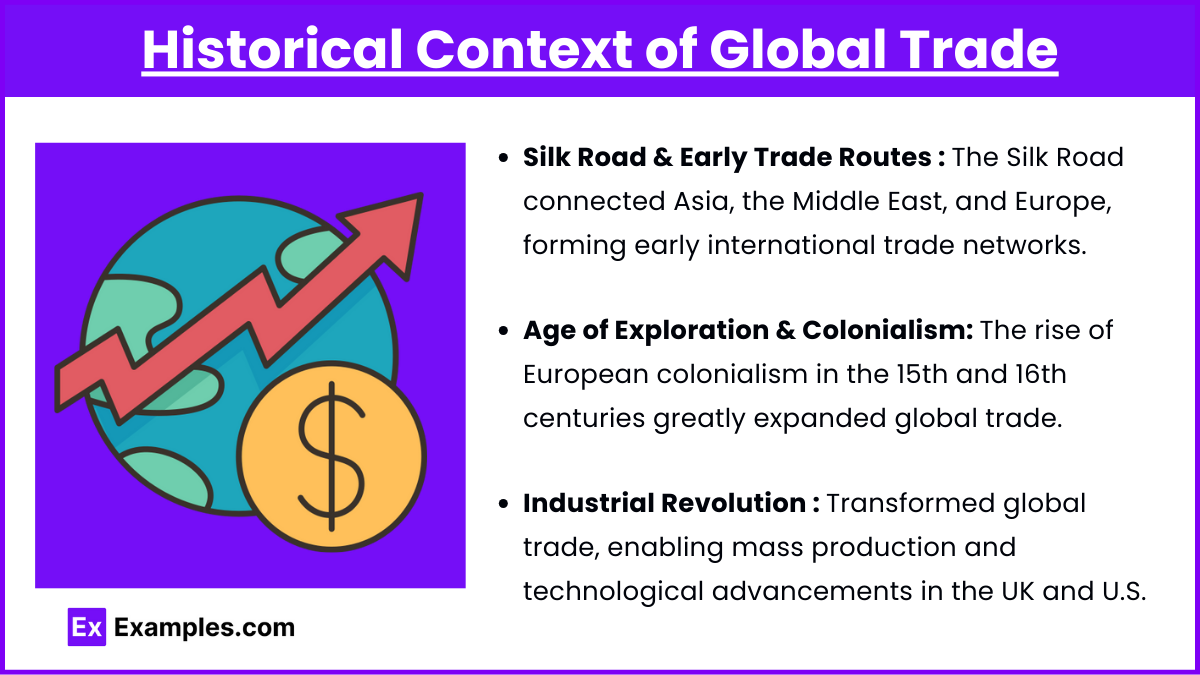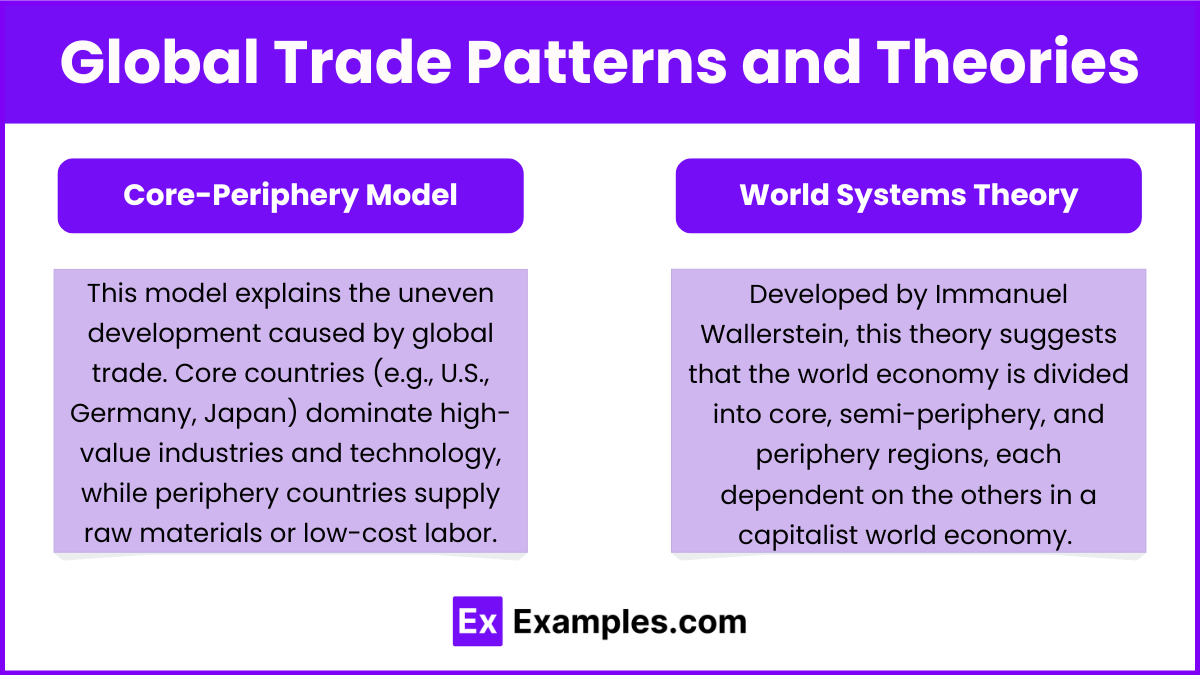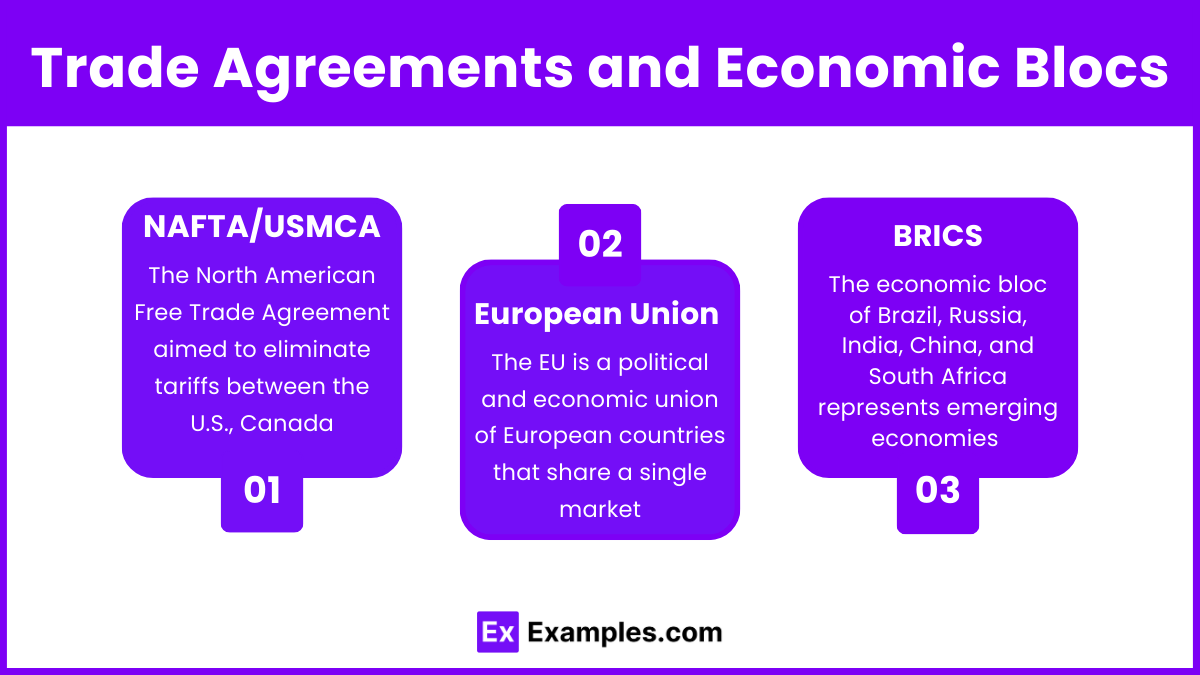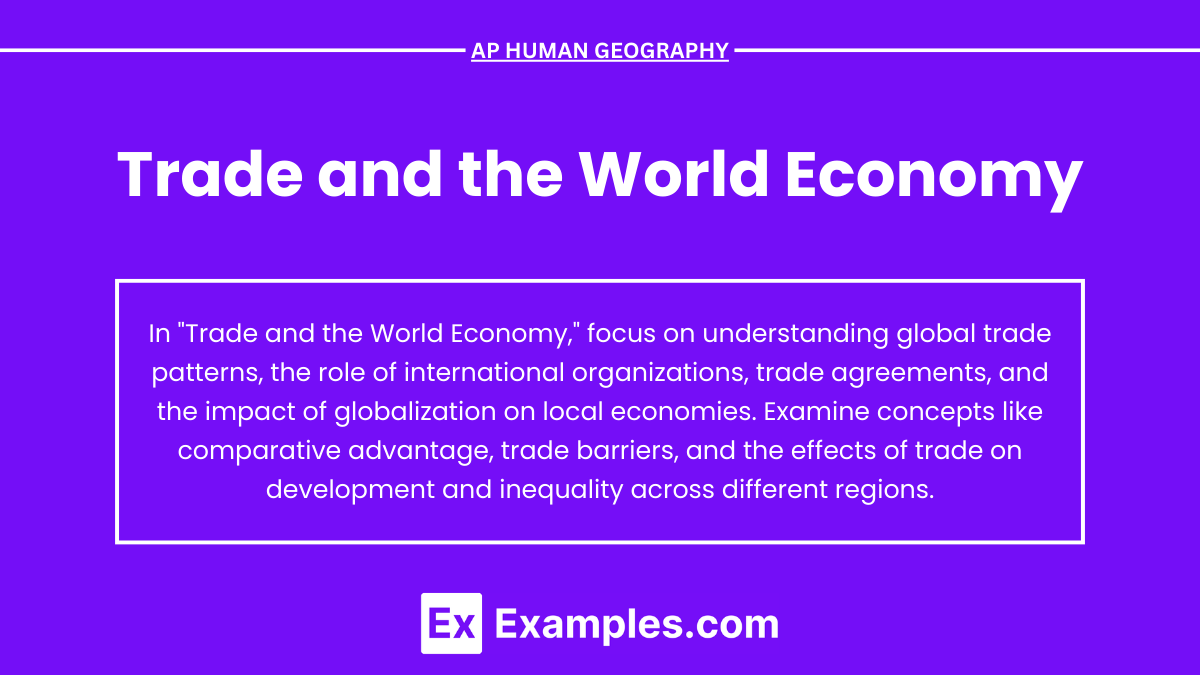Global trade is a crucial element of the world economy, influencing patterns of wealth, development, and cultural exchange. In the context of AP Human Geography, understanding trade involves examining historical trade routes, economic theories like comparative advantage, and the impact of globalization. Trade agreements and economic blocs shape international relations and affect local economies, while issues such as environmental sustainability and economic inequality arise from global trade practices. Analyzing these factors is essential for comprehending the complexities of our interconnected world.
Free AP Human Geography Practice Test
Learning Objectives
In studying "Trade and the World Economy" for AP Human Geography, you should aim to understand the historical evolution of global trade, including key concepts such as comparative advantage and global supply chains. Familiarize yourself with trade theories like the Core-Periphery Model and World Systems Theory, and analyze the impact of trade agreements and economic blocs on global relationships. Additionally, explore the effects of trade on economic development, environmental sustainability, and cultural globalization, while critically assessing challenges and criticisms associated with global trade practices.
Introduction to Trade and the World Economy
Trade is a fundamental component of the world economy, linking countries through the exchange of goods, services, and capital. It plays a key role in economic development, shaping global patterns of wealth, inequality, and innovation. For the AP Human Geography Exam, understanding trade's impact on global economies, geopolitical relations, and human geography is critical for achieving high scores.
Historical Context of Global Trade

Silk Road & Early Trade Routes: Early forms of trade like the Silk Road connected Asia, the Middle East, and Europe, laying the foundation for international trade networks. These routes facilitated the exchange of goods such as silk, spices, and ideas, promoting cultural diffusion.
Age of Exploration & Colonialism: The rise of European colonialism in the 15th and 16th centuries greatly expanded global trade. Colonial powers exploited resources from Asia, Africa, and the Americas, setting up systems of mercantilism where raw materials were extracted and finished products were shipped back to Europe.
Industrial Revolution: The Industrial Revolution transformed global trade in the 18th and 19th centuries, as mass production and technological advancements allowed countries like the UK and the U.S. to dominate manufacturing. Railroads, steamships, and the telegraph helped facilitate faster trade across oceans and continents.
Key Concepts in Global Trade

Comparative Advantage: This economic principle explains why countries specialize in producing goods where they have a lower opportunity cost. For example, a country with abundant fertile land may focus on agricultural exports, while another with advanced technology might specialize in electronics. This allows for efficient global trade, benefiting both trading partners.
Global Supply Chains: Modern trade is often structured around global supply chains, where different stages of production occur in different countries. For example, an iPhone might be designed in the U.S., with parts manufactured in China, Japan, and South Korea, and assembled in China.
Free Trade vs. Protectionism: Free trade policies, such as those promoted by the World Trade Organization (WTO), encourage the reduction of tariffs and trade barriers. However, protectionism—when countries impose tariffs or subsidies to protect domestic industries—can create friction in global trade.
Global Trade Patterns and Theories

Core-Periphery Model: This model explains the uneven development caused by global trade. Core countries (e.g., U.S., Germany, Japan) dominate high-value industries and technology, while periphery countries (e.g., many African or Latin American nations) supply raw materials or low-cost labor.
World Systems Theory: Developed by Immanuel Wallerstein, this theory suggests that the world economy is divided into core, semi-periphery, and periphery regions, each dependent on the others in a capitalist world economy. Core nations benefit the most from global trade, while peripheral nations are often exploited.
Trade Agreements and Economic Blocs

NAFTA/USMCA: The North American Free Trade Agreement (now replaced by the United States-Mexico-Canada Agreement) aimed to eliminate tariffs between the U.S., Canada, and Mexico, increasing trade within North America.
European Union (EU): The EU is a political and economic union of European countries that share a single market with free movement of goods, services, and people. It significantly boosts trade among member states.
BRICS: The economic bloc of Brazil, Russia, India, China, and South Africa represents emerging economies and challenges traditional trade dominance by Western nations.
Trade and Economic Development
Export-Led Growth: Countries such as South Korea, Taiwan, and China have pursued export-led growth, focusing on producing goods for international markets to drive economic development. This strategy has lifted millions out of poverty but can also lead to dependency on global market demand.
Fair Trade Movement: As a response to concerns over exploitation in global trade, the fair trade movement seeks to ensure that producers in developing countries receive fair wages and work in safe conditions. Fair trade products, such as coffee and chocolate, offer a more ethical alternative to traditional goods.
Examples
Example 1. The North American Free Trade Agreement (NAFTA)
NAFTA, implemented in 1994, created one of the world’s largest free trade zones by removing tariffs on goods traded among the United States, Canada, and Mexico. This agreement aimed to boost economic growth by facilitating trade and investment across North America. While it succeeded in increasing trade volume among the three countries, it also faced criticism for contributing to job losses in certain U.S. manufacturing sectors as companies relocated production to Mexico, where labor costs are lower. The agreement has since been renegotiated into the United States-Mexico-Canada Agreement (USMCA), which aims to address some of these issues while maintaining the benefits of free trade.
Example 2. The European Union (EU)
The EU represents a political and economic union of European countries that have established a single market allowing for the free movement of goods, services, people, and capital. By eliminating tariffs and regulatory barriers, the EU has enhanced trade among member states, resulting in increased economic integration and interdependence. This integration has led to greater economic stability and cooperation but has also raised concerns about loss of sovereignty and the economic disparities between member countries. The EU's trade policies and agreements with non-member countries further shape global trade dynamics, making it a significant player in the world economy.
Example 3. China’s Belt and Road Initiative (BRI)
Launched in 2013, China’s Belt and Road Initiative is a massive infrastructure and economic development project aimed at enhancing trade routes between Asia, Europe, and Africa. By investing in transportation, energy, and trade facilities, the BRI seeks to improve connectivity and stimulate economic growth in participating countries. However, it has faced criticism for creating debt dependency in smaller nations and for increasing China's influence on global trade dynamics. The BRI exemplifies how modern trade initiatives can reshape economic relationships and global power structures.
Example 4. The Rise of E-Commerce and Global Supply Chains
The growth of e-commerce platforms like Amazon and Alibaba has transformed how goods are traded globally. These platforms facilitate cross-border trade, allowing consumers to purchase products from around the world with ease. Additionally, global supply chains have become increasingly complex, with companies sourcing materials and manufacturing products in multiple countries to optimize costs and efficiency. This trend has reshaped labor markets, production practices, and international trade policies, emphasizing the interconnectedness of the global economy. However, it also raises concerns about labor standards and environmental impacts across different regions.
Example 5. The Fair Trade Movement
The Fair Trade movement promotes equitable trading conditions for producers in developing countries, ensuring they receive fair compensation for their goods. Fair Trade products, such as coffee, chocolate, and handicrafts, are often marketed as ethical alternatives to conventional goods. This movement seeks to address the inequalities inherent in global trade systems, where producers in poorer countries can be exploited by multinational corporations. By supporting Fair Trade practices, consumers can help create more sustainable and equitable trade relationships, highlighting the role of consumer choice in shaping the world economy.
Multiple Choice Questions
Question 1
Which of the following best describes the principle of comparative advantage?
A) Countries should produce everything they need domestically to avoid reliance on imports.
B) A country can produce goods at a lower opportunity cost than another country, leading to specialization and trade.
C) All countries should focus on exporting raw materials to maximize profits.
D) Trade barriers are necessary to protect domestic industries from foreign competition.
Correct Answer: B) A country can produce goods at a lower opportunity cost than another country, leading to specialization and trade.
Explanation: Comparative advantage is an economic principle that suggests countries will benefit from specializing in the production of goods where they have a lower opportunity cost compared to other countries. This leads to more efficient resource allocation and greater total production when countries engage in trade, allowing them to focus on what they do best and import what they need.
Question 2
What is one of the main purposes of trade agreements such as NAFTA (now USMCA)?
A) To limit trade between member countries.
B) To increase tariffs on imports from member countries.
C) To eliminate trade barriers and promote free trade among member countries.
D) To restrict the movement of labor across borders.
Correct Answer: C) To eliminate trade barriers and promote free trade among member countries.
Explanation: Trade agreements like NAFTA, which has been replaced by the USMCA, aim to facilitate trade by reducing or eliminating tariffs and other trade barriers among member countries. This promotes economic integration and increases trade flows, allowing countries to benefit from each other’s markets. Such agreements are crucial for enhancing economic cooperation and competitiveness in a globalized economy.
Question 3
Which of the following describes the concept of deindustrialization?
A) The process of countries developing new manufacturing technologies.
B) The decline of industrial activity in a region or country, often leading to job losses.
C) The increase in manufacturing jobs due to globalization.
D) The shift from agricultural to industrial economies in developing countries.
Correct Answer: B) The decline of industrial activity in a region or country, often leading to job losses.
Explanation: Deindustrialization refers to the decline of manufacturing industries in a region or country, often as a result of globalization and the relocation of production to countries with lower labor costs. This process can lead to significant job losses, economic restructuring, and social challenges as economies shift from manufacturing-based to service-oriented. Understanding deindustrialization is crucial in analyzing the impacts of global trade and economic change on local communities.


